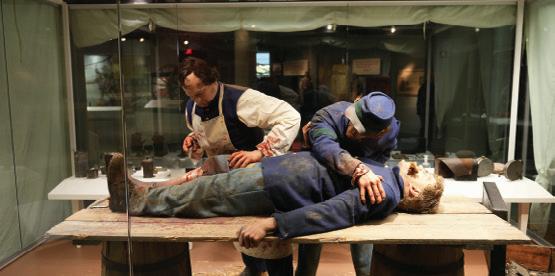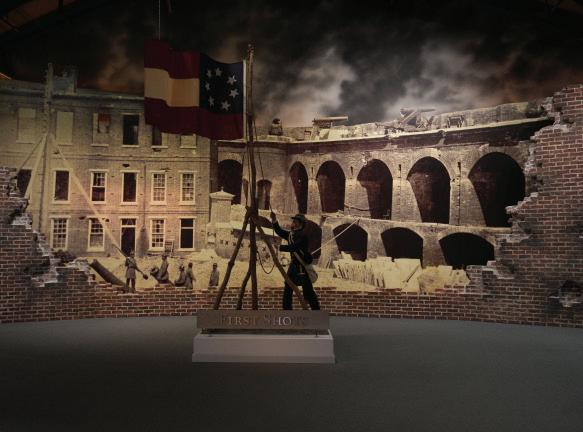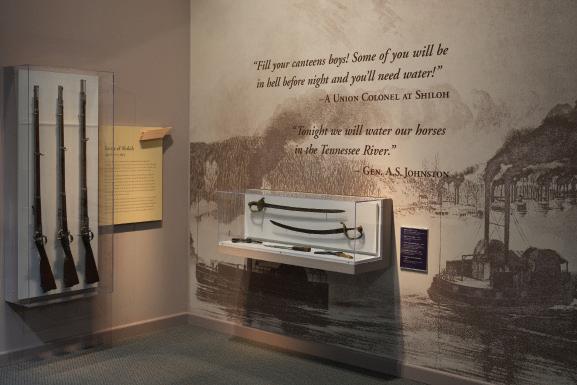
6 minute read
The National Civil War Museum: A Storehouse for History
Story by Christina Heintzelman: cheintzelman@benchmarkmediallc.com
Photos by Will Masters
Advertisement
What if we all believed that every effect must have its cause? That the past is the cause of the present and therefore the present will be the cause of the future?
The National Civil War Museum in Harrisburg speaks to this idea in their social justice mission statement: “The…mission is to serve as a national center to inspire lifelong learning of the American Civil War through the preservation and balanced presentation of the American peoples’ struggles for survival and healing. As we witness the ongoing divisiveness in our country more work needs to be done to achieve the founding principles of this country and the vision of our 16th president, Abraham Lincoln. To this end, we will continue to provide balanced programming as we have since the Museum’s inception. We intend to evolve our programmatic offerings and encourage open discussion to bring greater awareness of the relevancy of the events of the Civil War and its immediate aftermath to today’s citizenry. It is our hope these efforts will promote healing and equality for all citizens.
Jeffrey Nichols, CEO of The National Civil War Museum, says that the museum is one of the largest in the world dedicated solely to the study of the American Civil War. It opened in 2001 and aims to tell the entire, balanced story of this chapter in American history through historic information consisting of three-dimensional artifacts that allow visitors to see actual items used throughout the period, before, during, and after the war – both military items and common use items, archival records and photos, and dioramic exhibits and videos that involve the viewer through sight and sound. Northern and Southern viewpoints are presented as well as military and civilian perspectives. “There is twenty-five thousand square feet of exhibits that will give the viewer an excellent story of the American Civil War,” Nichols states. There are approximately sixteen galleries chronicling the beginning of slavery in the United States and the growing unrest, then moving through the making and training of armies on both sides, the motivations of both the Confederacy and the Union, campaigns fought and the weapons used, music played, the roles of women during the war, and the life and death of Abraham Lincoln.
The galleries also contain a large collection of original artifacts. Just to mention a few: there is an 1852 Sharps carbine and a pike head from the raid on Harper’s Ferry; the pen used by Governor Wise to sign John Brown’s death warrant; the last battle map used by General Robert E. Lee during the Appomattox campaign and his riding gauntlets, hat cord, and a Bible inscribed in his hand and used by him for almost twenty years. There is a sword belt presented to General Ulysses S. Grant to commemorate the capture of Vicksburg, and Major General George McClellan’s saddle used when he was General-in-Chief of the Union Army.
One of the galleries is devoted to Harrisburg’s role in the American Civil War due to the largest Federal training camp being housed in the eighty-acre area of land then used by the Dauphin County Agricultural Department as fairgrounds. After it was donated by Dauphin County for training use it was officially named Camp Curtin, for Pennsylvania Governor Andrew Curtin. More than three-hundred-thousand soldiers passed through this camp, and it also saw service as a supply depot, hospital, and prisoner-of-war camp. At the end of the war, Camp Curtin was used as a mustering-out point for thousands of troops on their way home. History also suggests that General Lee may well have been planning an attack on Harrisburg, because it is the capital city of Pennsylvania and also home to major railroad lines and waterways used for transportation of supplies.
There are changing exhibits which allow for special interest items from a specific era or subject to be viewed, such as Above and Beyond: Medal of honor Recipients of the Civil War, and another entitled Pieces of HistoryNew Acquisitions Exhibit, a display of artwork, rare and unique military commissions, carte de visites, documents, uniforms, and militaria. The second exhibit is sponsored by Abel and Son Roofing and Siding.
“This museum certainly was the brainchild of former Mayor Reed and his desire to make Harrisburg a destination city by building a museum like this. He began collecting artifacts during his tenure as mayor and slowly over time had enough to create this wonderful facility,” says Nichols. The city government, along with Mayor Reed, began building the museum in 2000 for its historic exhibit value as well as its destination desirability for tourism, given the proximity to Gettysburg and the National Military Park’s historic battlefields. It was built in Reservoir Park, the highest point in the city of Harrisburg with scenic vistas of the Blue Mountains, Susquehanna river valley, and the State Capitol. Nichols says that, even though the project was motivated by the city, the state did contribute through bonds and grants.
When the museum opened in 2001, there were twenty-thousand artifacts and archival pieces available for display. Today there are more than thirty-one-thousand pieces, thanks to the generosity of contributors who wish to see their personal memorabilia and artifacts safely housed and cared for, as well as to create the ability for others to view important historical artifacts.
Although two to three hours should be allowed for visiting the museum, if a visitor has only forty-five minutes for a tour, the exhibits are set up in a way that would allow a good overview of the history of the American Civil War within the shorter time frame. By following the exhibit from the beginning displays, which record events of 1619, through the dioramas allowing you to experience what people may have been facing back then, walking through the actual time-line of the war, and viewing artifacts associated with that period, one will walk away knowing more about this war - having a better sense of the causes, battles, and the eventual outcome - and perhaps understanding the cautionary tale told here of a country bitterly divided and prepared to battle fellow countrymen.


Nichols states, “This exhibit has held up for the entire 20 years it has been on display and this attributes to the designers and historians who put it together then, even discussing the events of 1619 long before the 1619 Project began its initiative in 2019.” The Museum is a partner in the Affiliate Program with the Smithsonian Institution and as such has access to historians, scholars, programs, and the borrowing of objects. “Not only that but it is a great resource for securing speakers and bouncing around ideas with their curators and historians. It is so beneficial for us to be a part of their program,” Nichols states.
People come to Harrisburg to visit the museum not only from across the United States but from all over the world. Pre-covid, the museum averaged about 40,000 visitors a year. School groups from all over the
Commonwealth find the museum a popular spot, but the museum is also creating online programs for students so they can receive information directly in their classrooms. An important goal of classroom education is to open students to the idea of critical thinking and gain a different perspective from what they have known in the past, allowing for the ability to look at the past and understand how it affects the present. Other areas within the museum and the museum grounds also hold a treasure trove for visitors. The library and archives are used mainly for research but are available to be seen by the public by calling and making an appointment. The gift shop has well curated items along with many interesting historical books for readers ranging from children to adults. Memorial bricks for the Walk of Valor are available for purchase and are exhibited on the outdoor walkway and arranged by state. Anyone can purchase a brick to memorialize a loved one who was engaged in the Civil War. There is also a special area specifically dedicated to the many African American troops who fought in the Civil War. All proceeds from these bricks go to the operation of the museum.
The entire museum is sixty-six thousand square feet, which includes meeting spaces, archival library, storage, and public event spaces. It requires a staff of five full time employees and a fluctuating number of part-time employees to care for the artifacts, keep the doors open, provide services and inside maintenance. “Often people will not think about the need for proper lighting and humidity control but the care, conservation, and maintenance of the collection for perpetuity is one of our most important goals,” Nichols states.
“Because the museum is a self-guided tour, it allows us to operate with a smaller staff. We are lean but we do a nice job of maintaining the site, having good programs, and hosting special events. So, like every other non-profit, it is always a challenge to find new sources of revenuesometimes through competitive state and federal grants - and continue to grow our membership base and do fundraising. Luckily the city, the community, and the county have been very supportive of us,” Nichols adds.
The National Civil War Museum is a participant in the Museums for All Program, a national access program that encourages individuals of limited means to access museums by presenting their SNAP EBT card when entering. The card allows up to four individuals per EBT card to view the museum free of charge.
See National Civil War Museum on Page 25
R e t e l l y o u r









